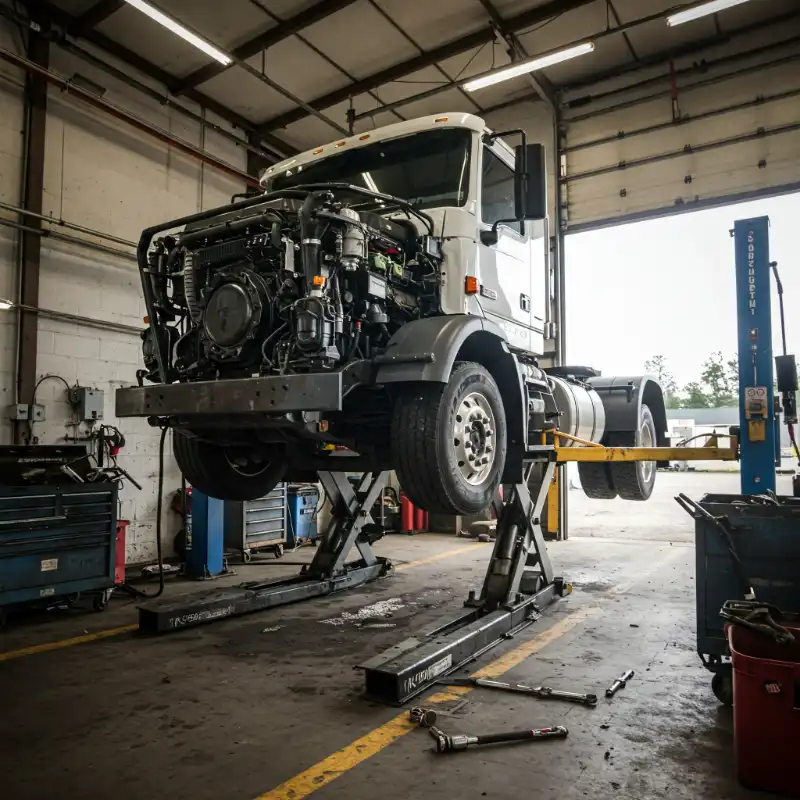Understanding Wheel Hubs
Wheel hubs ensure the safe and efficient operation of vehicles. These hubs are integral components that connect the wheels to the axle, allowing for smooth rotation and bearing the weight of the truck and its cargo. Understanding the components and types of wheel end hubs is essential for maintaining vehicle functionality and preventing costly downtimes.
Components of Wheel Hubs and Their Roles
A typical wheel hub assembly consists of several key components:
- Bearings: These are the heart of the hub, reducing friction and allowing the wheels to rotate smoothly.
- Seals: Seals prevent contaminants like dirt and water from entering the bearing assembly and protect the lubrication inside.
- Hub Assembly: The hub houses the bearings and is connected to the wheel and axle, transmitting torque from the axle to the wheel.
Types of Wheel Hubs
There are primarily two types of wheel hubs used in commercial trucks:
- Unitized Hubs: These hubs come as a single, pre-assembled unit. They are sealed and lubricated for life, requiring no maintenance and reducing the risk of contamination.
- Non-Unitized Hubs: These hubs allow for individual component replacement and require regular maintenance. They offer flexibility in terms of repair but demand more attention to ensure longevity.
Common Issues with Wheel Hubs
Despite their robust design, wheel hubs are susceptible to several issues impacting a truck's performance and safety. Understanding these common problems can help in early detection and prevention.
- Overheating: Proper lubrication is vital for the smooth operation of wheel hubs. Insufficient lubrication leads to increased friction, causing the components to overheat and wear prematurely. Overheating can result in bearing failure, posing a significant safety risk.
- Bearing Failure: Bearings in wheel end hubs are designed to handle heavy loads and high speeds. However, they can fail due to factors like improper installation, contamination, and lack of lubrication. Signs of bearing failure include unusual noises (like grinding or humming), vibrations, and decreased vehicle performance.
- Seal Leakage: Seals are crucial for keeping contaminants out and lubrication in. When seals leak, dirt, water, and other debris can enter the hub assembly, leading to contamination and accelerated wear of the bearings and other components. Regular inspection of seals can help identify leaks early.
- Corrosion and Rusting: Corrosion and rust can compromise the structural integrity of wheel end hubs. Exposure to moisture, road salt, and other corrosive elements can cause rusting, leading to weakened components and potential hub failure. Protecting the hubs from corrosive environments and using anti-corrosion treatments can mitigate this issue.
Maintenance Practices for Wheel End Hubs
Implementing regular maintenance practices is key to extending the life of wheel hubs and ensuring the safety and efficiency of commercial trucks.
Regular Inspection Procedures
Conducting routine inspections can help detect early signs of wear and damage, preventing minor issues from becoming major problems. During inspections, check for:
- Signs of lubricant leakage around seals.
- Unusual noises or vibrations during operation.
- Visible wear or damage on the hub and its components.
Proper Lubrication Techniques
Lubrication is crucial for reducing friction and preventing wear. Follow these lubrication tips:
- Use the recommended type and amount of lubricant specified by the manufacturer.
- Ensure the lubrication is evenly distributed across the bearings.
- Re-lubricate at intervals suggested by the hub manufacturer, especially for non-unitized hubs.
Correct Torque Specifications for Wheel Hub Components
Applying the correct torque to wheel end hub components during installation is essential for ensuring a secure fit and preventing premature failure. Over-torquing or under-torquing can cause damage to the bearings and other components. Always use a calibrated torque wrench and follow the manufacturer's specifications.
Importance of Cleanliness and Protection from Debris and Contaminants
Keeping the hub assembly clean and free from contaminants is vital. During maintenance and repairs:
- Clean all components thoroughly before reassembly.
- Protect the hub assembly from dirt and debris during installation.
- Use quality seals to prevent contamination.
Troubleshooting and Repair Tips
Even with diligent maintenance, issues can still arise. Knowing how to troubleshoot and repair wheel hubs can save time and reduce vehicle downtime.
Diagnosing Common Wheel Hub Issues
Early diagnosis of wheel end hub issues can prevent further damage. Look for these indicators:
- Noise: Grinding, humming, or clicking noises may indicate bearing issues.
- Vibration: Excessive vibration can signal imbalance or bearing failure.
- Heat: Overheating hubs can be a sign of inadequate lubrication or bearing problems.
Steps for Disassembly, Inspection, and Reassembly of Wheel Hubs
When issues are detected, follow these steps for disassembly, inspection, and reassembly:
- Disassembly: Carefully remove the hub assembly, noting the position and condition of each component.
- Inspection: Inspect bearings, seals, and other components for wear, damage, or contamination.
- Reassembly: Clean all parts thoroughly, replace any damaged components, and reassemble the hub, ensuring proper lubrication and torque specifications.
Replacement Guidelines for Worn-Out or Damaged Components
Replacing worn-out or damaged components can prevent further issues. Follow these guidelines:
- Replace bearings if there are signs of wear, pitting, or noise.
- Install new seals if they show signs of leakage or damage.
- Use OEM (Original Equipment Manufacturer) parts to ensure compatibility and quality.
Professional vs. DIY Repair Considerations
While some repairs can be handled in-house, others may require professional assistance. Consider the following:
- DIY Repairs: Suitable for routine maintenance and minor repairs if you have the necessary tools and expertise.
- Professional Assistance: Seek help for complex issues, lack of specialized tools, or if the repairs involve critical safety components.
Keep Your Wheels Turning!
Maintaining wheel hubs is vital for the safety and efficiency of commercial trucks. By understanding their components, recognizing common issues, following proper maintenance practices, and knowing when to seek professional help, you can ensure the longevity and reliability of your vehicle's wheel hubs. Regular inspections, proper lubrication, and adherence to manufacturer specifications are key to preventing hub-related problems and ensuring smooth, safe operations.
To learn more about our wheel repairs and services, click here!










.webp)





























